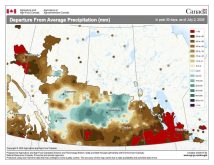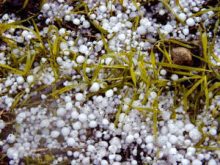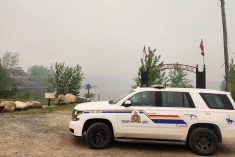The Southwest Flood Strategy Committee came together for the first time in almost two years Mar. 1, and it’s turning rapt eyes to the spring flood forecast.
The group was formed after the 2011 flood — which evacuated 7,100 people from their homes, damaged significant municipal infrastructure and left three million acres of farmland unseeded that year. It represents conservation districts, the Keystone Agricultural Producers, the cattle industry and what was over 30 municipalities prior to amalgamation in 2015.
- Read more: Runoff levels up in Saskatchewan’s forecast
- Read more: Manitoba storm may cause more than travel delays
Read Also

Thunderstorms and straight-line winds
Straight-line winds in thunderstorms can cause as much damage as a tornado and are next on our weather school list exploring how and why severe summer weather forms.
Chair Darryl Jackson says the committee hopes to meet with the province on flood concerns shortly, with a possible meeting Mar. 28.
“By then, we’ll have a little better idea of what we’re facing,” he said. “If March doesn’t get too warm too quick, but we get the same kind of weather we’ve been getting in February, that’ll be a good sign. If we get a big, heavy, wet dump of snow, there could be some issues. Don’t get me wrong, we’re not out of the woods, but it’s looking better than it did after Boxing Day when that third big snow-and-blow came in and really covered the ground white with several feet of snow in most places.”
According to the first 2017 provincial flood outlook, the Whiteshell lakes and lower Assiniboine, Red, Souris, Pembina and Roseau rivers are at major risk of spilling their banks, while the upper Assiniboine River, Interlake region and northern Manitoba hold a moderate risk of overland flooding.
“At this time, we encourage communities to continue with preparatory measures such as ensuring emergency protocols are in place,” Infrastructure Minister Blaine Pedersen said. “The province’s Hydrologic Forecast Centre will continue to closely monitor precipitation, spring melt and inflows from the northern United States in the Red River Basin and the Souris River Basin in the west. As the flood outlook becomes clearer, we want to ensure the safety of our communities and all Manitobans.”
The early-February heat wave, which saw temperatures soar above freezing and snow bases in southern Manitoba and North Dakota rapidly disappear, may not be enough to avoid spring flooding, the province now says.
While melting south of the international border has “slightly” reduced the risk of Red River flooding, “it has also left the soil saturated and prone to high run-off volumes from future precipitation,” according to the Feb. 27 flood outlook.
The Municipality of Souris-Glenwood is among those watching the flood forecast closely. Both Souris and Wawanesa built permanent dikes after the 2011 flood.
“There’s some lower-lying areas that we have flagged that would maybe need some protection for a couple of places,” chief administrator Charlotte Parham said, adding that materials and resources are available to fill that need.
Drainage ditches are also in place in the north end of Souris to divert overland flooding.
To the east, flood planning has become a recurring theme in RM of Portage la Prairie council meetings, according to Reeve Kam Blight.
The municipality has met with the provincial emergency measures co-ordinator and Infrastructure Minister Blaine Pedersen and is reviewing their emergency management plan.
“There’s not a whole lot we can do in preparation. We’re not going to be going out and building dikes, etc. at this time,” Blight said. “It’s not something that we’ve done in the past and it’s not necessarily a fit for our municipality.”
The geotube system (large tubes laid along Lake Manitoba’s shore to break waves, hold back water and prevent erosion) is still in place along Delta Beach, Blight said, and the RM will likely refortify some areas along Lake Manitoba as the snow recedes. The RM has also taken steps to add flood mitigation equipment and supplies.
The municipality has regularly weathered flood conditions in the past, including 2011, when already saturated soil and high precipitation led to severe damage along the shores of Lake Manitoba and overland flooding after a planned breach in the Hoop and Holler Bend near Portage la Prairie.
“We’ve learned a lot,” Blight said. “We have an idea where what we would call our ‘hot spots’ are; where people are going to be impacted, how the land is going to be impacted, where we’re going to have to really monitor and how high flows are going to impact — whether high flows are going down the Portage Diversion, the impact that’s going to have as compared to the high flows running down the Assiniboine River.”
The Hoop and Holler Bend, nearly breached again during western Manitoba’s 2014 flood, is also an area of concern.
“We’ve just got to know what to expect based on the different types of infrastructure that’s going to be used to mitigate the flood and also based on the total inflows coming in, we know what to expect and how to react,” Blight said.
The province released another warning Feb. 28, advising residents to stay off the ice on the Assiniboine River after flows from the Shellmouth Reservoir were reduced, potentially weakening the ice.
The province had been releasing water from the reservoir since late 2016 in an effort to bolster spring run-off capacity. The province reduced flow by 1,000 cubic feet per second March 1 after water levels reached the targeted low.




















